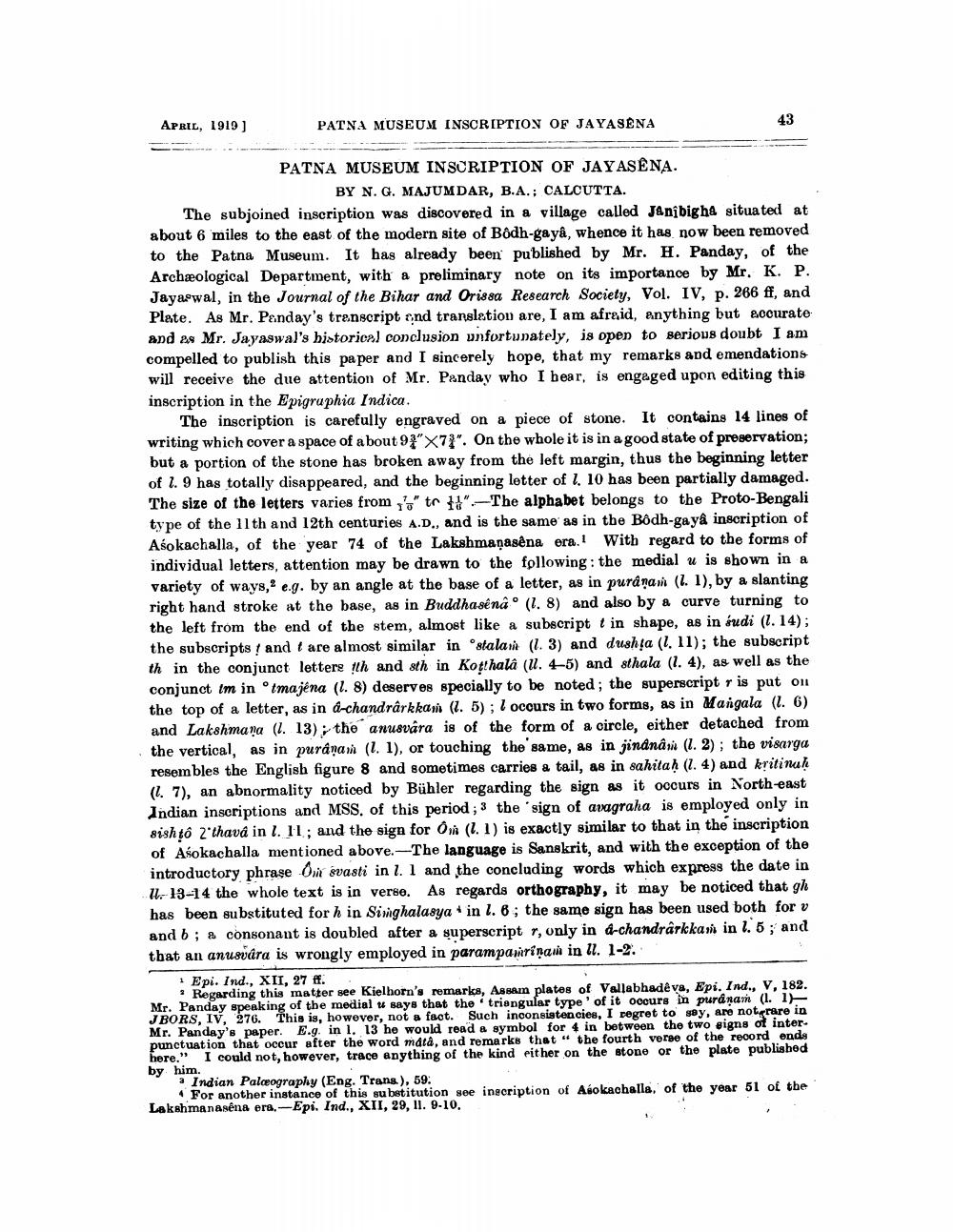________________
APRIL, 1919]
PATNA MUSEUM INSCRIPTION OF JAYASENA
43
PATNA MUSEUM INSCRIPTION OF JAYASENA.
BY N. G. MAJUMDAR, B.A.; CALCUTTA.
The subjoined inscription was discovered in a village called Janibigha situated at about 6 miles to the east of the modern site of Bôdh-gayâ, whence it has now been removed to the Patna Museum. It has already been published by Mr. H. Panday, of the Archæological Department, with a preliminary note on its importance by Mr. K. P. Jayaswal, in the Journal of the Bihar and Orissa Research Society, Vol. IV, p. 266 ff, and Plate. As Mr. Panday's transcript and translation are, I am afraid, anything but accurate and as Mr. Jayaswal's historical conclusion unfortunately, is open to serious doubt I am compelled to publish this paper and I sincerely hope, that my remarks and emendations will receive the due attention of Mr. Panday who I hear, is engaged upon editing this inscription in the Epigraphia Indica.
The inscription is carefully engraved on a piece of stone. It contains 14 lines of writing which cover a space of about 93"X7". On the whole it is in a good state of preservation; but a portion of the stone has broken away from the left margin, thus the beginning letter of l. 9 has totally disappeared, and the beginning letter of 1. 10 has been partially damaged. The size of the letters varies from" to "-The alphabet belongs to the Proto-Bengali type of the 11th and 12th centuries A.D., and is the same as in the Bôdh-gayâ inscription of Aśokachalla, of the year 74 of the Lakshmanasêna era. With regard to the forms of individual letters, attention may be drawn to the following: the medial u is shown in a variety of ways, e.g. by an angle at the base of a letter, as in puranam (l. 1), by a slanting right hand stroke at the base, as in Buddhasêna (1. 8) and also by a curve turning to the left from the end of the stem, almost like a subscript in shape, as in sudi (l. 14); the subscripts and t are almost similar in stalam (1. 3) and dushia (l. 11); the subscript th in the conjunct lettere th and 8th in Kotthalâ (l. 4-5) and sthala (1. 4), as well as the conjunct im in tmajêna (1. 8) deserves specially to be noted; the superscript r is put on the top of a letter, as in a-chandrârkkam (1. 5); l occurs in two forms, as in Mangala (l. 6) and Lakshmana (l. 13); the anusvára is of the form of a circle, either detached from the vertical, as in puranam (1. 1), or touching the same, as in jinânâm (1. 2); the visarga resembles the English figure 8 and sometimes carries a tail, as in sahitaḥ (1. 4) and kritinaḥ (l. 7), an abnormality noticed by Bühler regarding the sign as it occurs in North-east Indian inscriptions and MSS, of this period; 3 the sign of avagraha is employed only in sishtô 2'thava in 7. II; and the sign for Ôm (l. 1) is exactly similar to that in the inscription of Asokachalla mentioned above. The language is Sanskrit, and with the exception of the introductory phrase Ôm svasti in l. 1 and the concluding words which express the date in I. 13-14 the whole text is in verse. As regards orthography, it may be noticed that gh has been substituted for h in Singhalasya in l. 6; the same sign has been used both for v and b; a consonant is doubled after a superscript r, only in a-chandrârkkam in l. 5; and that an anusvára is wrongly employed in paramparinam in l. 1-2.
1 Epi. Ind., XII, 27 ff.
Regarding this matter see Kielhorn's remarks, Assam plates of Vallabhadêva, Epi. Ind., V, 182. Mr. Panday speaking of the medial u says that the triangular type' of it occurs in puranam (1. 1)JBORS, IV, 276. This is, however, not a fact. Such inconsistencies, I regret to say, are not rare in Mr. Panday's paper. E.g. in 1. 13 he would read a symbol for 4 in between the two signs of interpunctuation that occur after the word mátâ, and remarks that "the fourth verse of the record ends here." I could not, however, trace anything of the kind either on the stone or the plate published by him.
a Indian Palæography (Eng. Trans.), 59.
For another instance of this substitution see inscription of Asokachalla, of the year 51 of the Lakshmanasena era.-Epi. Ind., XII, 29, 11. 9-10.




